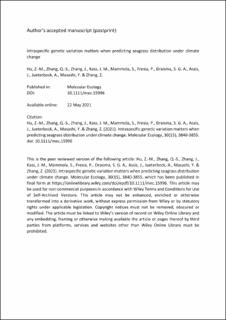| dc.contributor.author | Hu, Zi-Min | |
| dc.contributor.author | Zhang, Quan‐Sheng | |
| dc.contributor.author | Zhang, Jie | |
| dc.contributor.author | Kass, Jamie M. | |
| dc.contributor.author | Mammola, Stefano | |
| dc.contributor.author | Fresia, Pablo | |
| dc.contributor.author | Draisma, Stefano G. A. | |
| dc.contributor.author | Assis, Jorge | |
| dc.contributor.author | Jueterbock, Alexander | |
| dc.contributor.author | Masashi, Yokota | |
| dc.contributor.author | Zhang, Zhixin | |
| dc.date.accessioned | 2021-10-05T13:00:44Z | |
| dc.date.available | 2021-10-05T13:00:44Z | |
| dc.date.created | 2021-07-22T23:04:17Z | |
| dc.date.issued | 2021 | |
| dc.identifier.citation | Hu, Z.-M., Zhang, Q.‐S., Zhang, J., Kass, J. M., Mammola, S., Fresia, P., Draisma, S. G. A., Assis, J., Jueterbock, A., Masashi, Y. & Zhang, Z. (2021). Intraspecific genetic variation matters when predicting seagrass distribution under climate change. Molecular Ecology, 30(15), 3840-3855. doi: | en_US |
| dc.identifier.issn | 1365-294X | |
| dc.identifier.uri | https://hdl.handle.net/11250/2787779 | |
| dc.description | Author's accepted version (postprint). | en_US |
| dc.description | This is an Accepted Manuscript of an article published by Wiley in Molecular Ecology on 22/05/2021. | |
| dc.description | Available online: https://onlinelibrary.wiley.com/doi/epdf/10.1111/mec.15996 | |
| dc.description.abstract | Seagrasses play a vital role in structuring coastal marine ecosystems, but their distributional range and genetic diversity have declined rapidly in recent decades. To improve conservation of seagrass species, it is important to predict how climate change may impact their ranges. Such predictions are typically made with correlative species distribution models (SDMs), which can estimate a species’ potential distribution under present and future climatic scenarios given species’ presence data and climatic predictor variables. However, these models are typically constructed with species-level data, and thus ignore intraspecific genetic variability, which can give rise to populations with adaptations to heterogeneous climatic conditions. Here, we explore the link between intraspecific adaptation and niche differentiation in Thalassia hemprichii, a seagrass broadly distributed in the tropical Indo-Pacific Ocean and a crucial provider of habitat for numerous marine species. By retrieving and re-analysing microsatellite data from previous studies, we delimited two distinct phylogeographical lineages within the nominal species and found an intermediate level of differentiation in their multidimensional environmental niches, suggesting the possibility for local adaptation. We then compared projections of the species’ habitat suitability under climate change scenarios using species-level and lineage-level SDMs. In the Central Tropical Indo-Pacific region, models for both levels predicted considerable range contraction in the future, but the lineage-level models predicted more severe habitat loss. Importantly, the two modelling approaches predicted opposite patterns of habitat change in the Western Tropical Indo-Pacific region. Our results highlight the necessity of conserving distinct populations and genetic pools to avoid regional extinction due to climate change and have important implications for guiding future management of seagrasses. | en_US |
| dc.language.iso | eng | en_US |
| dc.publisher | Wiley | en_US |
| dc.rights | Attribution-NonCommercial-NoDerivatives 4.0 Internasjonal | * |
| dc.rights.uri | http://creativecommons.org/licenses/by-nc-nd/4.0/deed.no | * |
| dc.title | Intraspecific genetic variation matters when predicting seagrass distribution under climate change | en_US |
| dc.type | Peer reviewed | en_US |
| dc.type | Journal article | en_US |
| dc.description.version | acceptedVersion | en_US |
| dc.subject.nsi | VDP::Matematikk og Naturvitenskap: 400::Basale biofag: 470::Genetikk og genomikk: 474 | en_US |
| dc.subject.nsi | VDP::Matematikk og Naturvitenskap: 400::Zoologiske og botaniske fag: 480::Plantegeografi: 496 | en_US |
| dc.subject.nsi | VDP::Matematikk og Naturvitenskap: 400::Zoologiske og botaniske fag: 480::Økologi: 488 | en_US |
| dc.subject.nsi | VDP::Matematikk og Naturvitenskap: 400::Zoologiske og botaniske fag: 480::Marinbiologi: 497 | en_US |
| dc.source.pagenumber | 3840-3855 | en_US |
| dc.source.volume | 30 | en_US |
| dc.source.journal | Molecular Ecology | en_US |
| dc.source.issue | 15 | en_US |
| dc.identifier.doi | 10.1111/mec.15996 | |
| dc.identifier.cristin | 1922446 | |
| dc.relation.project | EC/H2020/882221 | en_US |

